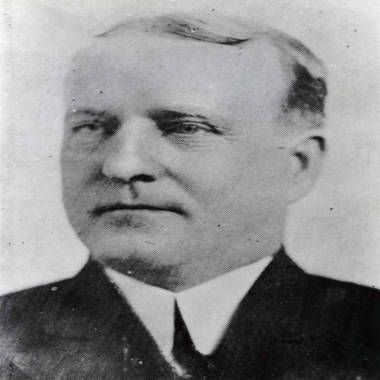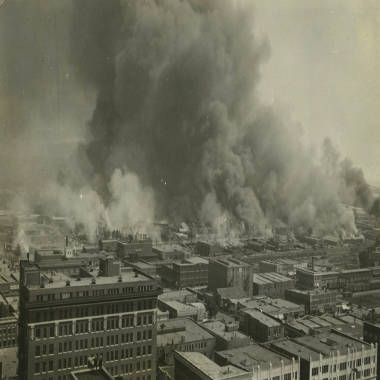
Sue Ogrocki / AP
People walk past The Tavern in the Brady Arts District in Tulsa, Okla., on June 27. The area is named after Wyatt Tate Brady, who was a member of the Ku Klux Klan.
By Justin Juozapavicius, Associated Press
TULSA, Okla. -- When Wyatt Tate Brady arrived here in 1890, Tulsa was just a spit of a town ? an untidy tangle of dirt streets and a handful of tents occupied by white men seeking their fortune in uncharted Indian lands.

Tulsa Historical Society via AP
A shoe salesman by trade, the brash and ambitious Missourian saw an opportunity and seized it. He opened a general store, followed by a hotel ? the first with baths.
By the time Oklahoma became a state in 1907, Brady was a celebrated city father. He signed Tulsa's incorporation papers, started a newspaper and chartered a train filled with boosters, including humorist Will Rogers, to promote the new boomtown to people in the East.
But a lesser-known side of Brady has become the focus of debate in his adopted hometown nearly 90 years after his death. The son of a Confederate veteran, Brady was a member of the local Ku Klux Klan. And new questions have emerged about his involvement in the most notorious event in Tulsa history, a 1921 race riot that left 300 black residents dead.
The issue is especially sensitive because Brady's name is all over town ? on a street, a mansion, a theater and a historic neighborhood. It's also the name of the city's most ambitious development effort in a generation ? a glitzy downtown entertainment district.
Brady's membership in the Klan was never a secret. It had been noted in Tulsa's historical records but was largely forgotten until a new Tulsa-based literary magazine, This Land, published a long article in late 2011 by author Lee Roy Chapman, who detailed Klan activities and Brady's involvement with the group.

Tulsa Historical Society via AP
Smoke rises over Tulsa's Greenwood District during race riots on June 1, 1921. The violence left 300 blacks dead and hundreds more wounded in a span of 18 hours.
Specifically, the article said, Brady created an environment of racism that led to the riot. Dozens of businesses were looted and burned to the ground, and the chaos decimated the Greenwood District, where grocers, newspapers, prominent doctors and attorneys had thrived in an area historians often call the Black Wall Street.
Even before the article was published, Tulsa had struggled to come to terms with its racial past. Black leaders had complained that the riot has been downplayed in local history. The city council, community leaders and residents are weighing what to do about a once-proud name that is suddenly tainted.
"There are councilors who are concerned and ashamed that we have this name, and we know what Mr. Brady stood for," said Jack Henderson, the council's lone black member who plans to introduce a law Thursday to rename Brady Street as Burlington Street.
Blacks account for roughly 16 percent of the city's population of 400,000.
Henderson's proposal, which is expected to come to a vote next week, reflects a recently discovered 1907 document on which someone crossed out Burlington Street and wrote Brady Street in its place.
The downtown area is "growing like it's never grown before," Henderson said in an interview. "So changing the name of the street isn't going to stop the momentum."
The council has asked business owners in the new Brady Arts District about the name, which is widely used in promotional marketing. The owners opposed any name change, concluding that it's better to be reminded of the city's checkered past in order to create a better world.
"Rather than seeking to revise history, today's residents, visitors and merchants should regard the name as a demonstration of a new set of principles," they said in a July 14 letter. "Removing the name is to surrender to the past."
Business owners have also protested that changing the name of the street would confuse visitors and hurt sales, among other concerns.
Most politicians have remained mum on the issue. Others quarrel with the idea that Brady was a major instigator of the riot. Mayor Dewey Bartlett said he's read accounts that showed disagreement over Brady's role in the unrest.
The mayor wants to keep the Brady name, citing concern that the renaming effort could become a slippery slope for other streets and landmarks named after people with questionable pasts.
"We look at history as a good teacher, not something to emulate, obviously, but in this case something to learn from and avoid," Bartlett said in an interview. "My opinion, I guess, is that I have not heard a strong groundswell of support for changing the name and to what? What are we going to call it next?"
The entertainment district is at the core of Tulsa's effort to rejuvenate its moribund downtown, which had long been pocked with half-empty offices, blank storefronts and weeds. The improvements come after the city invested decades, and many millions of dollars, in failed attempts to revive the area.
Today the district has been reborn. It has a new ballpark, boutiques, a cigar bar, trendy restaurants and a museum and park dedicated to Oklahoma's Dust Bowl balladeer, Woody Guthrie. The elegant Brady Theater is one of the jewels, opened by Brady in 1914 as the biggest arena between Kansas City and Houston. It's now a popular showplace for indie and classic rock shows.
"We've been here over six years, and no one seemed to notice or care" about renaming Brady Street, said Janet Duvall, executive director of the Tulsa Glassblowing School, one of many specialty shops that have taken root along the street in question. "The success is finally here, and now we think we need to put someone else's name on it."
Others say the name can serve as an omnipresent reminder of "never again" as the city moves ahead.
"It's like changing the name of the city of Tulsa because it has a racist past," said Kuanza Johnson, a California transplant and teacher, who is black and lives in the Brady Heights Historic District. "Where do you stop?"
Anna Taylor, a white resident of the historic district, agrees, saying the city need not dredge up the battles of the past.
"It's not going to change anything," she said.
Confusion over the name seems especially apparent in the Brady Heights neighborhood, a section of large, nearly 100-year-old homes, including the Greek Revival-style mansion Brady built in 1920 and named Arlington, after Robert E. Lee's Virginia estate.
Once home to business barons, the neighborhood is now is full of young families in fixer-uppers and newcomers to the city. Until recently, many never even knew who the district was named for.
Still, "You don't revamp history," said Susan Kufdakis, who lives with her parents in Brady's old mansion, which has been turned back into a single-family house after being divided up in apartments. "You shouldn't forget who Brady was, but you keep history the way it is."

Sue Ogrocki / AP
Elba Kufdakis, left, and daughter Susan Kufdakis speak outside the historic Brady Mansion in Tulsa, Okla., on June 27.
This story was originally published on Thu Jul 25, 2013 4:20 AM EDT
? 2013 The Associated Press. All rights reserved. This material may not be published, broadcast, rewritten or redistributed.
anna nicole smith Meagan Good janelle monae Jessica Korda tour de france erykah badu The Heat
No comments:
Post a Comment
Note: Only a member of this blog may post a comment.